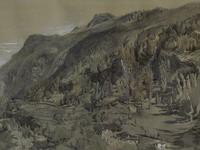John Ruskin and the Geographical Imagination
Denis Cosgrove selects works from Ruskin’s Teaching Collection and reveals a poetry of landscape that inspired geographical learning a century ago.

Ruskin readily embraced photography in its earliest forms, using photographic images to record monuments threatened with 'restoration', to capture details for later art work, and to illustrate his studies of places such as Venice and Amiens. Like Halford Mackinder, who commissioned photographs of key locations across the empire for teaching geography by lantern slide, Ruskin was alert to the visual power and immediacy of the photographed landscape. But he regarded the lack of visual discrimination in the photographed image as a threat to the imaginative truth of landscape art.

Tomb of Count Castelbarco, Verona
'… taken before its restoration; very noticeable in preservation of the slabs of marble composing its roof, with so little decay of importance, from the fifteenth century.' (21: 195) '… the rough Count of Castelbarco, none one of whose words was ever written, or remains; and whose portrait, by no means that of a man of literary genius, almost disfigures, by its plainness, the otherwise grave and perfect beauty of his tomb.' (23:54, 9:175-177)

Tomb of Can Mastino and Can Signorio, seen together
'… showing the equestrian statue foreshortened in its grandest position … Relieved by sharp sunlight on the gable of the earlier tomb are seen the figures of Adam and Eve.' (21:197; 19:438-9)

Coloured Photograph of Landscape
'Anything more beautiful than the photographs of the Valley of Chamouni, now in your print-sellers’ windows, cannot be conceived. For geographical and geological purposes they are worth anything; for art purposes, worth – a good deal less than zero. You may learn much from them, and will mislearn more. But in Turner’s "Valley of Chamouni" the mountains have not a fold too much, or too little. There are no such mountains at Chamouni: they are the ghosts of eternal mountains, such as have been, and shall be, for evermore.' (22:220)






Examples of Cheap Modern Woodcuts
As well as photographs, Ruskin used other mass produced images to illustrate his arguments about the integrity of art. These woodcuts, taken from a 'Compendium of Geography and Travel' claim to illustrate the physiognomy of 'aboriginal' peoples, an example of the 'scientific racism' which dominated Victorian geography and anthropology. 'No microscope can teach the beauty of a statue, nor can any woodcut represent that of a nobly bred human form; but only last term we saw the whole Ashmolean Society held in a trance of rapture by the inexplicable decoration of the posteriors of a flea; and I have framed for you here, around a page of the scientific journal which styles itself Knowledge, a collection of woodcuts out of a scientific survey of South America, presenting collectively to you, in designs ignorantly drawn and vilely engraved, yet with the peculiar advantage belonging to the cheap woodcut, whatever, through that fourth part of the round world, from Mexico to Patagonia, can be found of savage, sordid, vicious, or ridiculous in humanity, without so much as one exceptional indication of a graceful form, a true instinct, or a cultivable capacity.' (33 'Art of England' para.131)
References
All references to Ruskin's writings are taken from The Works of Ruskin, Library Edition, 39 volumes, edited by E.T. Cook and Alexander Wedderburn, George Allen, London, 1903-1912 and given by volume number and page.




